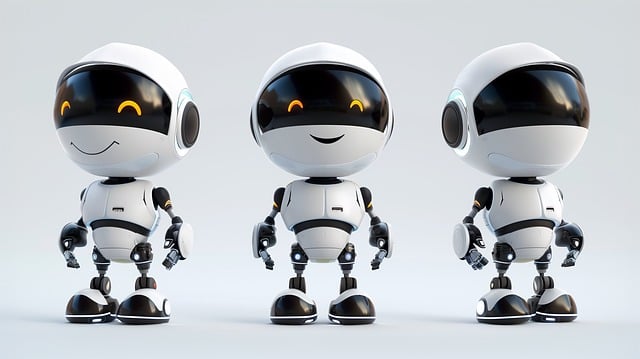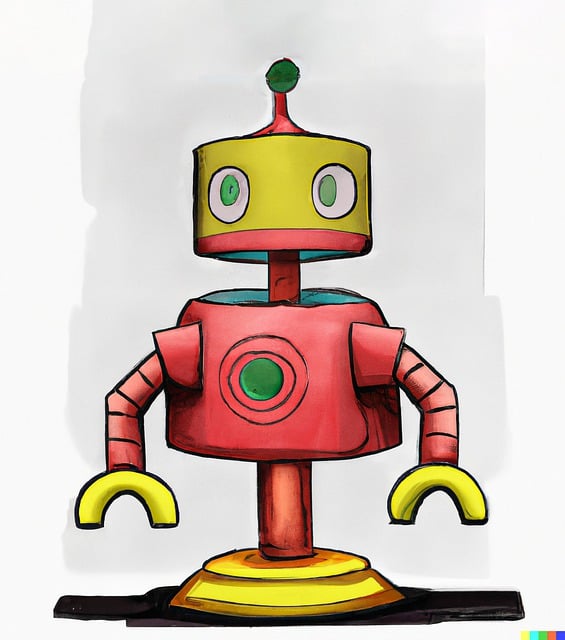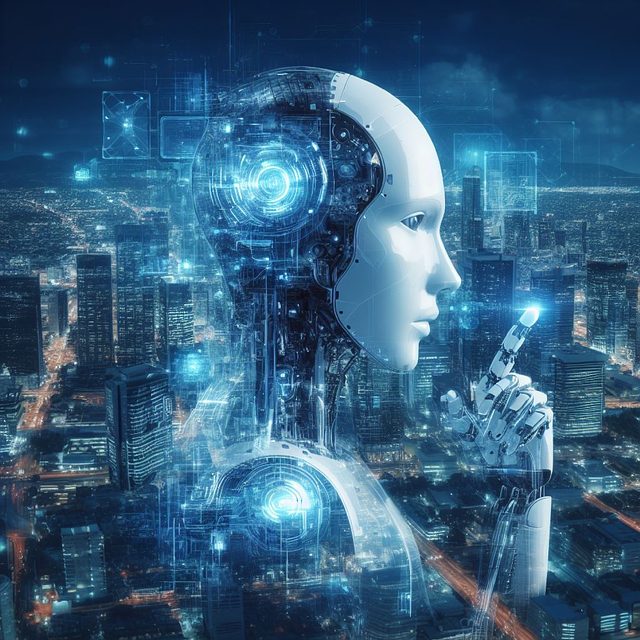Venturing into the realm of artificial intelligence, an AI chatbot stands as a pivotal innovation in the digital landscape. This article demystifies the process of building an AI chatbot, from grasping its capabilities and applications to meticulously designing its conversation flow. We’ll delve into the core components, including natural language processing and machine learning algorithms that power these interactive entities. Furthermore, we’ll explore best practices for integrating, testing, deploying, and maintaining your chatbot to ensure it meets user expectations and scales effectively. A comprehensive guide on AI chatbots awaits, offering insights into transforming your idea into an intelligent conversational partner.
- Understanding AI Chatbots: A Primer on Their Capabilities and Uses
- Key Components of an AI Chatbot: From Natural Language Processing to Machine Learning Algorithms
- Designing the Conversation Flow: Crafting Effective Dialogues and Response Strategies
- Integrating and Testing Your Chatbot: Ensuring Functionality and User Satisfaction
- Deploying and Maintaining Your AI Chatbot: Best Practices for Scalability and Continuous Improvement
Understanding AI Chatbots: A Primer on Their Capabilities and Uses

AI chatbots represent a sophisticated blend of artificial intelligence, natural language processing, and machine learning technologies. They are designed to simulate human conversation by understanding user input through text or voice and providing relevant responses. These systems can be integrated into various platforms, from customer service applications and virtual assistants to advanced personal helpers and educational tools. Chatbots are programmed with rules and patterns that enable them to handle a wide array of queries, tasks, and interactions, making them versatile and scalable for businesses and users alike.
The capabilities of AI chatbots continue to evolve, becoming more nuanced and sophisticated over time. They can perform functions ranging from simple tasks like setting reminders or answering FAQs to more complex activities such as scheduling appointments, providing personalized recommendations, and even assisting in diagnosing certain medical conditions. The key to their effectiveness lies in the continuous learning process they undergo, which allows them to improve their understanding of language nuances and user preferences. As a result, chatbots are increasingly becoming an integral part of the digital interaction landscape, offering a seamless blend of utility and efficiency in our daily lives.
Key Components of an AI Chatbot: From Natural Language Processing to Machine Learning Algorithms

Building an AI chatbot involves integrating several key components that work in harmony to simulate human-like conversation. At the core of every AI chatbot lies Natural Language Processing (NLP), which enables the system to understand and interpret human language. NLP encompasses various tasks such as tokenization, part-of-speech tagging, parsing, named entity recognition, sentiment analysis, and more. These processes allow the chatbot to break down user input into meaningful components that can be processed and responded to intelligently.
Beyond NLP, machine learning algorithms are pivotal in equipping AI chatbots with the ability to learn from interactions and improve over time. These algorithms can be supervised, unsupervised, or reinforcement learning models, each tailored to different aspects of conversation management. Supervised learning models help the chatbot understand context and intent by training on pre-labeled datasets, while unsupervised models can identify patterns in user queries, enabling more personalized responses. Reinforcement learning models allow the chatbot to adapt to novel situations by reinforcing successful interactions, thereby enhancing its performance continuously. The synergy of these components, from understanding and processing language to adapting and evolving through machine learning, is what makes AI chatbots a valuable tool for businesses looking to automate customer service, engage with users on various platforms, or simply provide an interactive experience.
Designing the Conversation Flow: Crafting Effective Dialogues and Response Strategies

When designing an AI chatbot, a pivotal aspect is crafting a conversation flow that feels natural and intuitive to users. This involves meticulously creating dialogues that can effectively guide conversations and elicit appropriate responses from users. The initial step in this process is to outline the potential scenarios in which the chatbot will interact with users, considering various intents and entities that users might employ. Each conversation path should be mapped out with clear decision points that allow the chatbot to navigate through different topics or clarify user requests.
Developers must consider the nuances of human language and anticipate a wide range of user inputs. This includes preparing the chatbot for ambiguous queries, typos, and even out-of-scope inquiries. Response strategies should be designed to handle such situations gracefully, providing users with helpful follow-up questions or clear error messages. Utilizing natural language processing (NLP) techniques, AI chatbots can interpret context and user sentiment, enabling them to respond more accurately and maintain a coherent conversation flow. By incorporating machine learning algorithms, these chatbots can continuously improve their performance over time, adapting to new patterns in user interactions and refining their dialogues for enhanced user experience. This iterative approach ensures that AI chatbots evolve with the conversations they engage in, making each interaction more enriching than the last.
Integrating and Testing Your Chatbot: Ensuring Functionality and User Satisfaction

Building an AI chatbot involves more than just programming conversational algorithms; it requires rigorous integration and testing processes to ensure that the chatbot functions as intended and delivers a satisfying user experience. Once the chatbot’s underlying architecture, including its natural language processing (NLP) engine, decision-making logic, and integration points for various communication platforms are in place, the next critical step is comprehensive testing. This phase involves simulating a wide range of interactions to assess the chatbot’s responses, speed, accuracy, and adaptability. Testers should employ a diverse set of user queries, including both typical and edge-case scenarios, to validate the chatbot’s functionality across different use cases and languages.
To achieve high levels of user satisfaction, it’s crucial to test the chatbot in real-world environments with actual users. This user acceptance testing phase allows for the identification of any unexpected behaviors or areas where the chatbot may fall short in terms of user expectations. Collecting and analyzing user feedback during this stage is paramount; it helps refine the chatbot’s conversational abilities, improve response quality, and enhance overall user engagement. By iteratively testing and fine-tuning the chatbot with real interactions, developers can ensure that their AI chatbot not only understands and responds to user inputs effectively but also provides a seamless and enjoyable user experience. This iterative process is key to successful AI chatbot deployment and can significantly impact user satisfaction and retention rates.
Deploying and Maintaining Your AI Chatbot: Best Practices for Scalability and Continuous Improvement

Deploying an AI chatbot is a significant milestone in your project, but it’s just the beginning. To ensure your chatbot scales effectively and continues to improve over time, it’s crucial to establish robust deployment strategies and maintain a rigorous process for iterative enhancement. Initially, choose a scalable infrastructure that can handle varying loads without performance degradation. Cloud-based solutions are often ideal for this purpose due to their flexibility and ability to automatically adjust resources based on demand. Monitoring tools should be integrated to track usage patterns and system performance, allowing you to allocate the necessary computing power and optimize response times accordingly.
Once deployed, continuous improvement is key. Gather user interactions, feedback, and error logs diligently. Use this data to refine the chatbot’s conversational algorithms and expand its knowledge base. Implement A/B testing to compare different versions of your chatbot and identify which one performs better. Adopt a model-driven approach that enables rapid iteration, where updates are made without significant downtime. Furthermore, stay abreast of advancements in AI and natural language processing (NLP) to integrate cutting-edge features into your chatbot, thereby enhancing its capabilities and maintaining its relevance in the ever-evolving digital landscape. Regularly update your chatbot with new training data to ensure it understands and responds appropriately to an expanding array of user queries. By prioritizing scalability and continuous improvement, you can ensure your AI chatbot remains a valuable tool for users and continues to adapt to their changing needs.
Building an AI chatbot involves a multifaceted approach that encompasses understanding its capabilities, designing its conversation flow, integrating and testing it, and maintaining it for continuous improvement. By leveraging key components such as natural language processing and machine learning algorithms, your chatbot can become an invaluable tool across various sectors, enhancing user engagement and streamlining operations. As you embark on this journey, keep in mind the importance of meticulous design and testing to ensure functionality and user satisfaction. With careful planning and adherence to best practices for deployment and maintenance, your AI chatbot has the potential to become a cornerstone of customer interaction and service delivery. Incorporating these strategies will set your chatbot apart, ensuring it remains effective and adaptable in an ever-evolving digital landscape.
